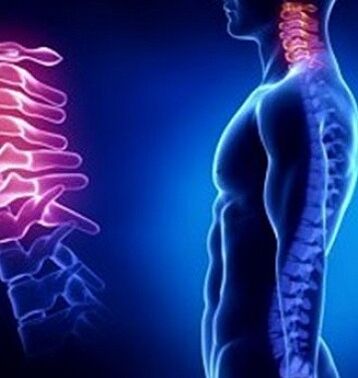
With osteochondrosis, there is a gradual destruction of the tissues of the spine, which leads to a violation of its function. Usually such degenerative processes develop in their most mobile departments. In young people, cervical osteochondrosis is most often observed. The instability of this department, combined with increased physical activity, explains its susceptibility to injuries and various dystrophic processes. 3 times out of 10, it's what causes a sudden headache. Osteochondrosis provokes a metabolic disorder in the spine. Because of this, the discs inside stick out and then break.
symptoms
Several signs can indicate dystrophic changes in the spine. Depending on the stage of the disease, they are more or less pronounced. Cervical osteochondrosis has the following symptoms:
- Pain in the neck, neck, shoulder. Reinforced even with light loads.
- numbness in the limbs.
- Cracking when turning the neck.
- Headaches localized mainly in the back of the head and temples.
- fainting, chronic fatigue.
- Ringing in the ears, hearing loss.
- loss of visual acuity.
A cervical osteochondrosis can also be indicated by drawing pains in the heart area. The patient often has sensations similar to angina pectoris. When the spinal root is pinched, other disorders also occur. For example, loss of tongue sensation or decreased neck muscle tone, breathing problems. If treatment is not prescribed on time, the patient may develop a protrusion or hernia.
There are four stages of osteochondrosis. The first is characterized by instability of the intervertebral discs. On the second side, protrusions are considered the main character. In this case, the gaps between the vertebrae become smaller. There is a pain syndrome, which can be accompanied by pinched nerve roots.
In the third stage, the fibrous ring, which is an essential part of the intervertebral disc, is destroyed. Therefore it deforms afterwards. A patient with fourth-stage cervical osteochondrosis feels severe pain with every movement. It should be noted that a decrease in intensity does not indicate recovery. On the contrary, this indicates that the process of formation of osteophytes connecting the vertebrae has begun. This usually leads to disability. Treatment is prescribed based on clinical signs and the stage of development of the pathology.
causes of the disease

Sedentary work is most often accompanied by cervical osteochondrosis. This section of the spine is quite compact, and therefore even slight muscle tension in it leads to compression of nerve endings and blood vessels. Against this background, osteophytes are often formed, which only aggravates the situation. In addition to a sedentary lifestyle, the disease can be triggered by:
- metabolic disorders;
- malnutrition;
- salt deposits in the cervical spine;
- hypothermia;
- hereditary predisposition;
- injuries to the cervical spine;
- Rheumatism.
The cause of the development of the disease can also be a curvature of the spine or being overweight. The risk group includes people with poor physical fitness or athletes who make mistakes in the training process.
Which doctor treats cervical osteochondrosis?
In order to avoid the development of complications at the first signs of pinching the nerve roots of the spine, you should contact a specialist. Cervical osteochondrosis and its symptoms are treated by neurologists, chiropractors and osteopaths.
In addition, you may need to consult a neurosurgeon, traumatologist, therapist or cardiologist. To differentiate the diagnosis, the doctor analyzes the patient's complaints. At this stage he asks the patient the following questions:

- When did the neck pain first appear?
- Do other symptoms accompany cervical osteochondrosis?
- Does the patient's occupation involve lifting weights or keeping the neck in a motionless position for long periods of time?
- What is the patient's fitness level?
- Does the patient have signs of neurological disorders?
To assess the condition of the spine, the doctor prescribes X-rays, CT or MRI. Depending on the symptoms and stage of the condition, treatment may include massage, swimming, and exercise therapy. Local destruction processes are influenced by acupuncture. With severe pain syndrome, the doctor prescribes anesthetics. The tension in the muscles is relieved by muscle relaxants. In advanced cases, when the patient has a hernia that compresses the roots of the spinal cord, surgical intervention is required.
What if the disease is not treated?
In the absence of qualified medical care, the patient eventually develops chronic pain in the cervical spine. It radiates to the upper and lower limbs, which is fraught with paralysis. As osteophytes grow, they compress nerve canals, veins, and arteries. This can disrupt the process of cerebral circulation. Often this provokes ischemia and strokes. The patient also worsens vision, hearing, migraines and vegetative-vascular dystonia appear.
When examining cervical osteochondrosis and its clinical symptoms, doctors often diagnose radiculopathy. It leads to a partial or complete loss of vertebral mobility. The occurrence of exacerbations is a reason for the patient's hospitalization. Compression of the spinal cord is considered the most serious consequence of cervical osteochondrosis. The risk of death in this case is quite high. In order to avoid the development of complications, it is necessary to consult a doctor as soon as possible. The way of working should be gentle. Every day you should do special gymnastics, and if possible, morning exercises.




























